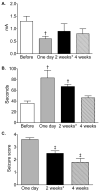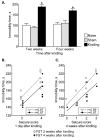Kindling epileptogenesis in immature rats leads to persistent depressive behavior
- PMID: 17368107
- PMCID: PMC1958957
- DOI: 10.1016/j.yebeh.2007.02.001
Kindling epileptogenesis in immature rats leads to persistent depressive behavior
Abstract
Depression is a frequent comorbidity in epilepsy patients. A variety of biological factors may underlie epilepsy-associated depression. We examined whether kindling-induced chronic increase in seizure susceptibility is accompanied by behavioral symptoms of depression. Three-week-old Wistar rats underwent rapid kindling: 84 initially subconvulsant electrical stimulations of ventral hippocampus delivered every 5 minutes, followed by depression-specific behavioral tests performed 2 and 4 weeks later. Kindled animals exhibited a sustained increase in immobility time in the forced swim test and the loss of taste preference toward calorie-free saccharin, as compared with controls. Initial loss of preference toward the intake of calorie-containing sucrose was followed by the increased consumption at 4 weeks. At both time points, animals exhibited enhanced seizure susceptibility on test stimulations of the hippocampus. We conclude that neuronal plastic changes associated with the kindling state are accompanied by the development of depressive behavior.
Figures




Similar articles
-
Kindling epileptogenesis and panic-like behavior: Their bidirectional connection and contribution to epilepsy-associated depression.Epilepsy Behav. 2017 Dec;77:33-38. doi: 10.1016/j.yebeh.2017.10.001. Epub 2017 Nov 5. Epilepsy Behav. 2017. PMID: 29107199 Free PMC article.
-
Influence of carbamazepine on kindling grades in depressive and non-depressive rats.Georgian Med News. 2010 May;(182):68-71. Georgian Med News. 2010. PMID: 20587836
-
Influence of ionizing radiation on the course of kindled epileptogenesis.Brain Res. 2006 Jun 13;1094(1):207-16. doi: 10.1016/j.brainres.2006.03.096. Epub 2006 Jun 8. Brain Res. 2006. PMID: 16762327
-
An experimental model of progressive epilepsy: the development of kindling of the hippocampus of the rat.Ital J Neurol Sci. 1995 Feb-Mar;16(1-2):45-57. doi: 10.1007/BF02229074. Ital J Neurol Sci. 1995. PMID: 7642351 Review.
-
The phenomenology of limbic kindling.Toxicol Ind Health. 1994 Jul-Oct;10(4-5):343-58. Toxicol Ind Health. 1994. PMID: 7539949 Review.
Cited by
-
Issues related to symptomatic and disease-modifying treatments affecting cognitive and neuropsychiatric comorbidities of epilepsy.Epilepsia. 2013 Aug;54 Suppl 4(0 4):44-60. doi: 10.1111/epi.12298. Epilepsia. 2013. PMID: 23909853 Free PMC article. Review.
-
High Frequency of Depressive Symptoms among Adults with Epilepsy: Results from a Hospital-based Study.J Neurosci Rural Pract. 2017 Aug;8(Suppl 1):S13-S19. doi: 10.4103/jnrp.jnrp_21_17. J Neurosci Rural Pract. 2017. PMID: 28936065 Free PMC article.
-
Depression, stress, epilepsy and adult neurogenesis.Exp Neurol. 2012 Jan;233(1):22-32. doi: 10.1016/j.expneurol.2011.05.023. Epub 2011 Jun 12. Exp Neurol. 2012. PMID: 21684275 Free PMC article. Review.
-
Rhythm and blues: animal models of epilepsy and depression comorbidity.Biochem Pharmacol. 2013 Jan 15;85(2):135-46. doi: 10.1016/j.bcp.2012.08.016. Epub 2012 Aug 23. Biochem Pharmacol. 2013. PMID: 22940575 Free PMC article. Review.
-
Rapid Amygdala Kindling Causes Motor Seizure and Comorbidity of Anxiety- and Depression-Like Behaviors in Rats.Front Behav Neurosci. 2016 Jun 22;10:129. doi: 10.3389/fnbeh.2016.00129. eCollection 2016. Front Behav Neurosci. 2016. PMID: 27445726 Free PMC article.
References
-
- Gilliam FG, Santos J, Vahle V, Carter J, Brown K, Hecimovic H. Depression in epilepsy: ignoring clinical expression of neuronal network dysfunction? Epilepsia. 2004;45(Suppl 2):28–33. - PubMed
-
- Kanner AM. Epilepsy, suicidal behaviour, and depression: do they share common pathogenic mechanisms? Lancet Neurol. 2006;5:107–8. - PubMed
-
- Hermann BP, Seidenberg M, Bell B. Psychiatric comorbidity in chronic epilepsy: identification, consequences, and treatment of major depression. Epilepsia. 2000;41 (Suppl 2):31–41. - PubMed
-
- Forsgren L, Nystrom L. An incident case-referent study of epileptic seizures in adults. Epilepsy Res. 1990;6:66–81. - PubMed

